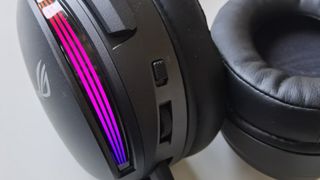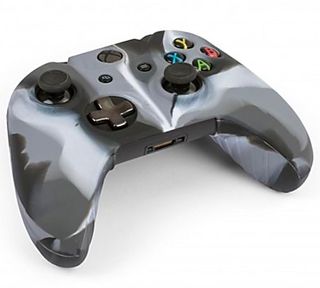TechRadar Verdict
A really impressive gaming headset that does the essentials superbly: it sounds great, has a quality feel, scores highly for surround sound and microphone quality, and is light and comfortable. Perfect for both competitive FPS-playing and MMOs. But it is best suited paired with a PC rig and if hooked up to Microsoft’s current-gen consoles will require an extra headset adapter for your controller.
Pros
- +
Great neutral but dynamic sound
- +
Really usable surround-sound
- +
Clever microphone with noise cancellation
- +
Extra set of MMO-specific ear-cushions
- +
Feels classy and robust
Cons
- -
Software app only works on the PC
- -
LEDs on earcups are a gimmick
- -
Geared toward PC use
Why you can trust TechRadar
Asus, via its Republic Of Games (ROG) sub-brand, is one of the biggest names in PC gaming, making everything from power supply units, motherboards, and monitors to mice and keyboards. In recent years, it has started to add gaming headsets to its repertoire, gaining a solid if unspectacular reputation.
Its latest gaming headset, the ROG Fusion II 500, is a mid to high-end effort that is wired (generally less hassle, in our opinion, since you don’t have to worry about battery life) and billed as suitable for any platform you fancy hooking it up to, including the current and previous generation of consoles, PC, tablets, and smartphones.
Asus ROG Fusion II 500 price and availability
The Asus ROG Fusion II 500 gaming headset is available now and will cost you $179.99 (£199.99 and AU$267.57).
At that price, you should also consider the best PC gaming headsets, as there may be something more to your tastes. If you're looking to spend less then check out the best budget gaming headsets.
Design

The ROG Fusion II 500 nevertheless creates a great first impression: it manages to be both light and durable – a vital consideration for any gaming headset which will, at some point, find itself being flung around the room in frustration. Cheaper headsets often achieve that strength using hard, ugly plastics, but the ROG Fusion II 500 makes a decent tactile impression, with faux leather on its headband and quality, robust, plastics elsewhere.
The headset highlights Asus’s PC gaming background with one prominent feature: big LED stripes on each earcup, which can be made to light up in a variety of garish ways (strobing rainbows, color progressions, and the like) through Asus’s Armoury Crate software. Frankly, that’s pretty gimmicky – you can’t see the LEDs when you’re wearing the headset – and it rather illustrates the fact that the ROG Fusion II 500, despite its cross-platform claims, is geared towards use with a PC.
There’s no way of downloading Armoury Crate (which also provides graphic equalization, and lets you update the firmware and tweak various settings) to any of the consoles. And to get the LEDs to work, you must connect a second lead as well the 3.5mm headphone jack (which, commendably, is detachable rather than hardwired to the headset) – a USB-C to USB-C which has a USB-C to USB-A adaptor. You can hook that up to one of your console’s USB ports, and the LEDs will light, but you’ll have to sit uncomfortably close to your console, and it all feels a bit pointless.
As far as real-world use is concerned, it’s easy enough to adjust the ROG Fusion II 500’s settings according to whatever type of gaming session you’re enjoying: clicking the main volume knob inwards on the left earcup turns surround sound on and off, there’s a microphone mute switch which is easy to find and the right earcup sports a knob which adjusts the balance between in-game audio and chat – to make use of that when playing on a console, you must flip a switch above it to a console rather than PC setting, which again rather belies the headset’s PC-centric nature. It’s a bit difficult to read the graphic for that switch, so you’ll probably have to take the headset off to make sure you’ve got it right.
Audio

Living without its flashing LEDs is a minor imposition, though, given that the ROG Fusion II 500 does the important jobs required of any gaming headset so well. It has plenty of tech under the hood which leads to a great sound: crisp, clear, and precise, yet with plenty of bass and punch. It leans more towards a neutral, realistic sound than some gaming headsets which can over-emphasize the bass in an attempt to sound dynamic. In contrast, the ROG Fusion II 500 just sounds effortlessly dynamic.
That sound is underpinned by all sorts of technological trickery, including no fewer than four Digital-Analogue Converters (DACs), each assigned to its own frequency band, and airtight driver chambers. However, the specifics aren’t important: all you need to know is that the efforts made by Asus’s engineers have paid off in terms of audio performance.
It also sports an excellent virtual 7.1 surround-sound implementation, which feels accurate and precise. It was good enough to provide plenty of advance directional information for incoming aliens in Rainbow Six Extraction, and often proved handy in Elden Ring (when you frequently hear unseen NPCs calling you as you ride around the map).
Microphone quality

Playing Rainbow Six Extraction, my squad-mates also appreciated the ROG Fusion II 500’s unusual but effective built-in mic setup. It has no microphone boom, but instead uses two hidden “beamforming” microphones that target the wearer’s mouth, along with AI-based noise cancellation. It delivered clear voice-chat, and should be able to do so even in extremely noisy environments; it certainly excelled in moderately noisy environments such as a lounge in a shared house with music playing.
Comfort
The ROG Fusion II 500 also scores highly in terms of comfort. That’s largely due to its lightness, but also due to the softness of its leather trim. It comes with a second pair of ear cushions – unlike the standard ones, they’re made of hybrid materials, rather than leather, and are designed to be breathable, specifically for playing marathon MMORPG sessions. We found that even with the standard ear-cushions, there were no comfort issues when wearing the headset for over two hours solid. Asus bills the ROG Fusion II 500 as ideal for those who primarily play first-person shooters and MMOs (that is, the sort of gamers who are in real need of a decent headset), and it’s impossible to disagree with that assessment.

However, there is one spanner in the works, which admittedly isn’t the fault of the headset itself but is something that afflicts all gaming headsets that claim to be platform-agnostic. With the Series X and Series S consoles, Microsoft has reduced the power output from the 3.5mm jack on its controllers, rendering the ROG Fusion II 500 unacceptably lacking in volume. The problem was easily rectified by clipping an Xbox audio adapter, adding some pre-amplification, into the Series X controller (a £25 Turtle Beach Audio Controller Plus which we already owned). But if you aren’t keen on buying an extra piece of kit, and mainly use a Series X or Series S, you’d be better off with a headset specifically designed to work with those consoles.
The ROG Fusion II 500 has all the essential attributes that constitute a top-class gaming headset: great audio performance, usable surround-sound, a clever microphone setup that offers really good noise cancellation, comfort, and build quality. As far as those aspects are concerned, it’s good enough to compete with more expensive headsets, which is something of an accolade.
But it feels more like a PC gaming headset that can also be hooked up to consoles, rather than a truly cross-platform one. Asus’s attempt, via its Armoury Crate app, to give you fine control over all its products in one place makes perfect sense if you’re a PC gamer, but less so if you primarily play on consoles. We can strongly recommend the headset for PC gamers, and it operates superbly on any console you hook it up to bar the Xbox Series X and S. It’s a great headset, but nowhere near as cross-platform as Asus would have you believe.

Buy it if...
You’re a PC gamer looking for a mid-priced headset that sounds like a more expensive one, and is built to last.
You’re a PC gamer who also owns and frequently uses a non-Microsoft console.
You have a Microsoft Series X or Series S and are prepared to also splash out on a headset adapter for your controller.
Don't buy it if...
You’re a console gamer and are primarily attracted by a headset that has programmable LEDs on its earcups.
You own an Xbox Series X or Series S and aren’t prepared to spend an extra £25 on a headset adapter for your controller.

